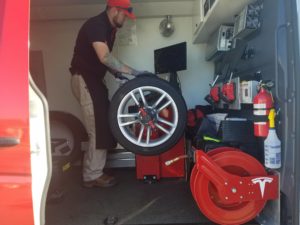Professional Mobile Tire Repair in Las Vegas - Rapid Service Assured
Professional Mobile Tire Repair in Las Vegas - Rapid Service Assured
Blog Article
Tire Service: Proven Approaches for Ideal Tire Maintenance and Treatment
From making certain appropriate tire stress to normal rotation and placement, there are tried and tested approaches that can significantly prolong the life-span of your tires and enhance general driving experience. Allow's delve into the world of tire service and find the keys to maintaining your tires in top-notch form for the long haul - Flat Tire Repair Las Vegas.
Relevance of Tire Stress
Adequate tire pressure promotes much better gas efficiency, as under-inflated tires can lead to increased rolling resistance, creating the engine to work more challenging and eat more gas. Appropriate tire pressure makes certain also walk wear, improving tire longevity and conserving cash in the long run by delaying the requirement for early replacements. On a regular basis changing and examining tire stress, especially in the past long journeys, is an easy yet efficient method to improve automobile efficiency, expand tire life-span, and focus on safety and security on the roadway.
Tire Rotation Guidelines
When thinking about tire rotation guidelines, it is vital to recognize the importance of this upkeep job in making the most of tire life expectancy and keeping ideal automobile performance. Tire rotation entails transforming the placement of each tire on an automobile to ensure even tread wear. Front tires tend to wear a lot more quickly than back tires as a result of guiding forces, making regular turning critical for well balanced wear patterns. The suggested rotation pattern differs depending on whether a vehicle is front-wheel, rear-wheel, all-wheel, or four-wheel drive. Commonly, tires need to be turned every 5,000 to 7,500 miles, or as encouraged in the car manual. Disregarding tire rotation can lead to irregular wear, impacting handling, traction, and possibly compromising vehicle safety and security. By adhering to correct turning standards, chauffeurs can extend the life of their tires, boost fuel effectiveness, and boost overall driving experience. Normal rotation is a simple yet effective upkeep practice that adds considerably to tire longevity and lorry performance.

Benefits of Wheel Alignment
Ensuring correct wheel positioning after tire turning is important for maintaining balanced wear patterns and making best use of vehicle performance. Wheel placement refers to the modification of the angles of the wheels to the supplier's specifications. Among the crucial advantages of wheel placement is enhanced handling and guiding response. When the wheels are correctly straightened, it minimizes guiding effort, ensuring a smoother and extra controlled driving experience. Furthermore, correct wheel positioning assists to expand the life-span of your tires. Misaligned wheels Read Full Report can trigger irregular tire wear, leading to early tire replacement and increased upkeep prices.

Tire Footstep Deepness Check
Executing a normal examination of tire walk depth is crucial for keeping risk-free driving conditions and prolonging the life expectancy of your tires. Uneven step wear can suggest issues with tire alignment, suspension, or stress, highlighting the value of regular walk deepness checks. By including tire walk deepness checks into your routine maintenance schedule, you can drive with confidence recognizing that your tires are in top problem.
Seasonal Tire Inspection
Seasonal tire inspection is a fundamental aspect of tire upkeep that guarantees tires are ready to face the challenges posed by various weather condition conditions. In preparation for winter season, it is important to check the tire stress routinely as cold temperature levels can you could try these out cause tire pressure to drop. By conducting routine seasonal tire inspections, vehicle drivers can lengthen tire life expectancy, boost gas efficiency, and most notably, make sure a protected driving experience in varying climate conditions.
Final Thought
To conclude, maintaining proper tire pressure, rotating tires routinely, lining up wheels correctly, checking walk depth, and carrying out seasonal examinations are essential techniques for optimal tire treatment. By following these confirmed methods, drivers can ensure their tires last longer, execute much better, and add to general vehicle safety. It is essential to prioritize tire maintenance to stop mishaps, boost fuel effectiveness, and lengthen the lifespan of tires.
Ample tire pressure promotes far better fuel effectiveness, as under-inflated tires can lead to raised rolling resistance, triggering the engine to work harder and consume even more fuel.When thinking about tire turning guidelines, it is essential to understand the relevance of this maintenance task in making best use of tire lifespan and preserving ideal lorry efficiency. Seasonal tire examination is a basic aspect of tire upkeep that makes certain tires are ready to encounter the challenges postured by different weather condition conditions. By carrying out routine seasonal tire evaluations, chauffeurs can extend tire lifespan, improve gas efficiency, and most notably, make certain a protected driving experience in varying climate problems.
In conclusion, keeping proper tire stress, turning tires consistently, straightening wheels appropriately, checking tread deepness, and carrying out seasonal evaluations are vital methods for optimum tire care.
Report this page